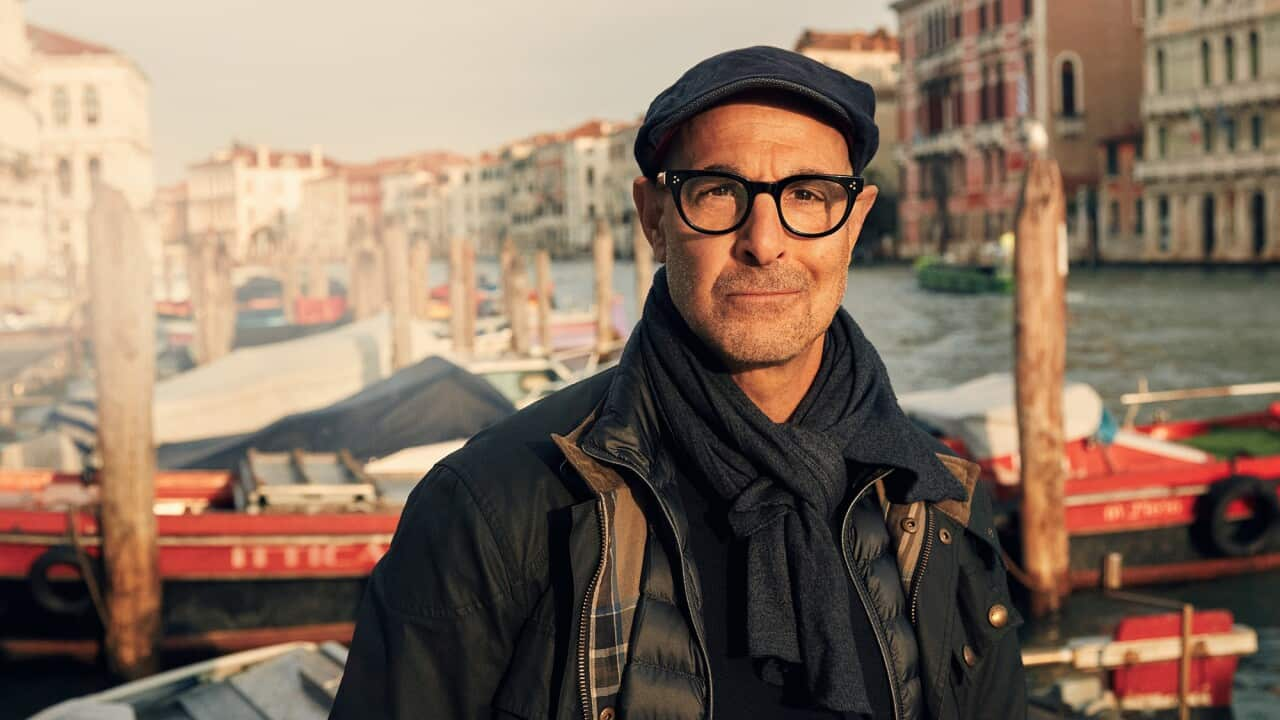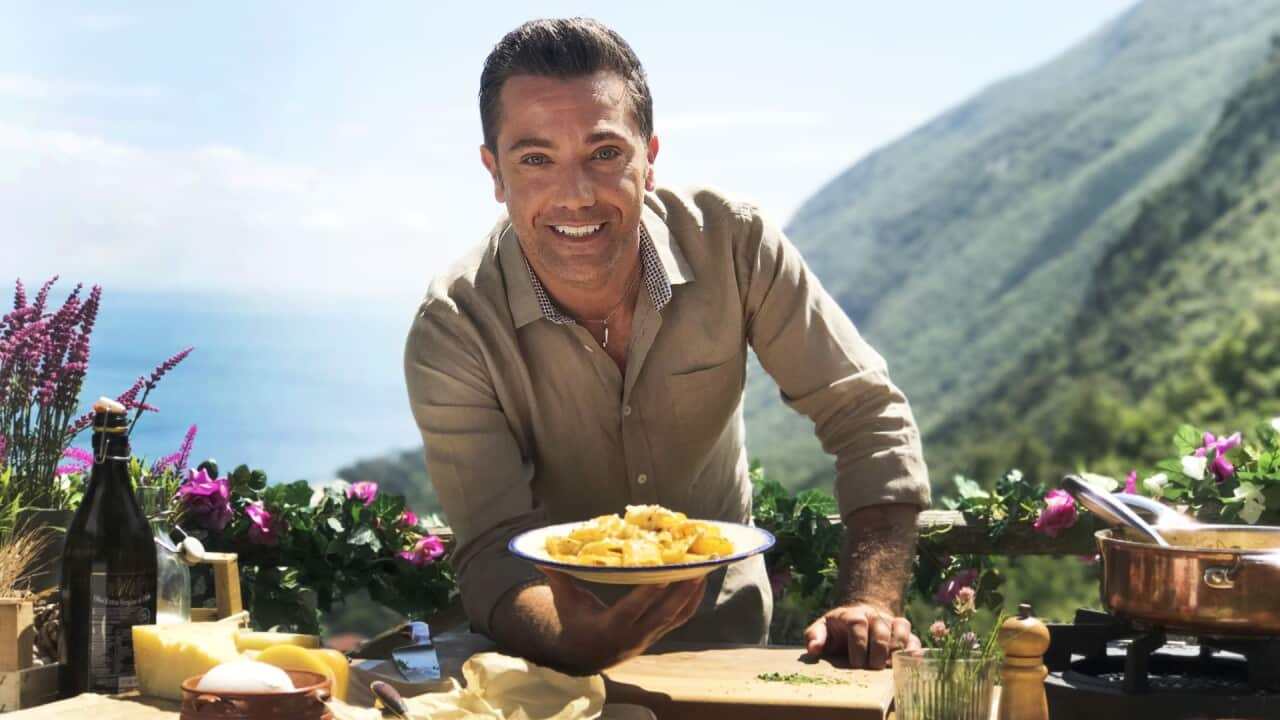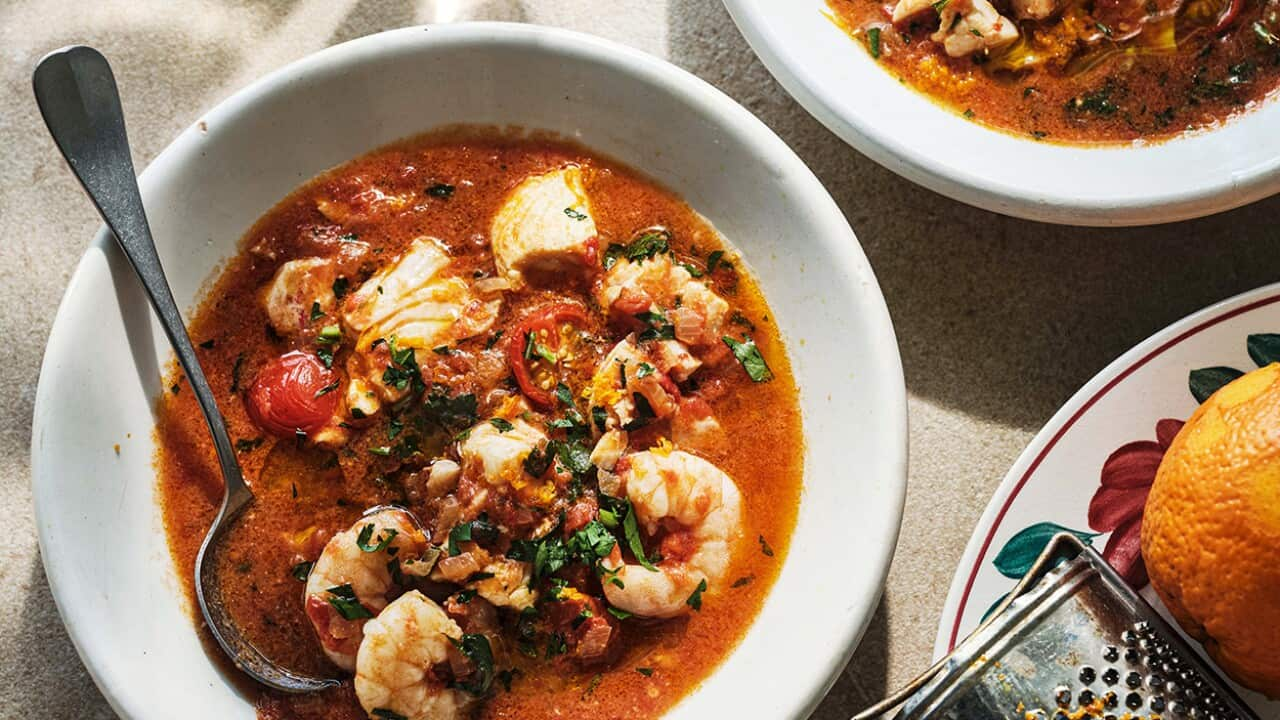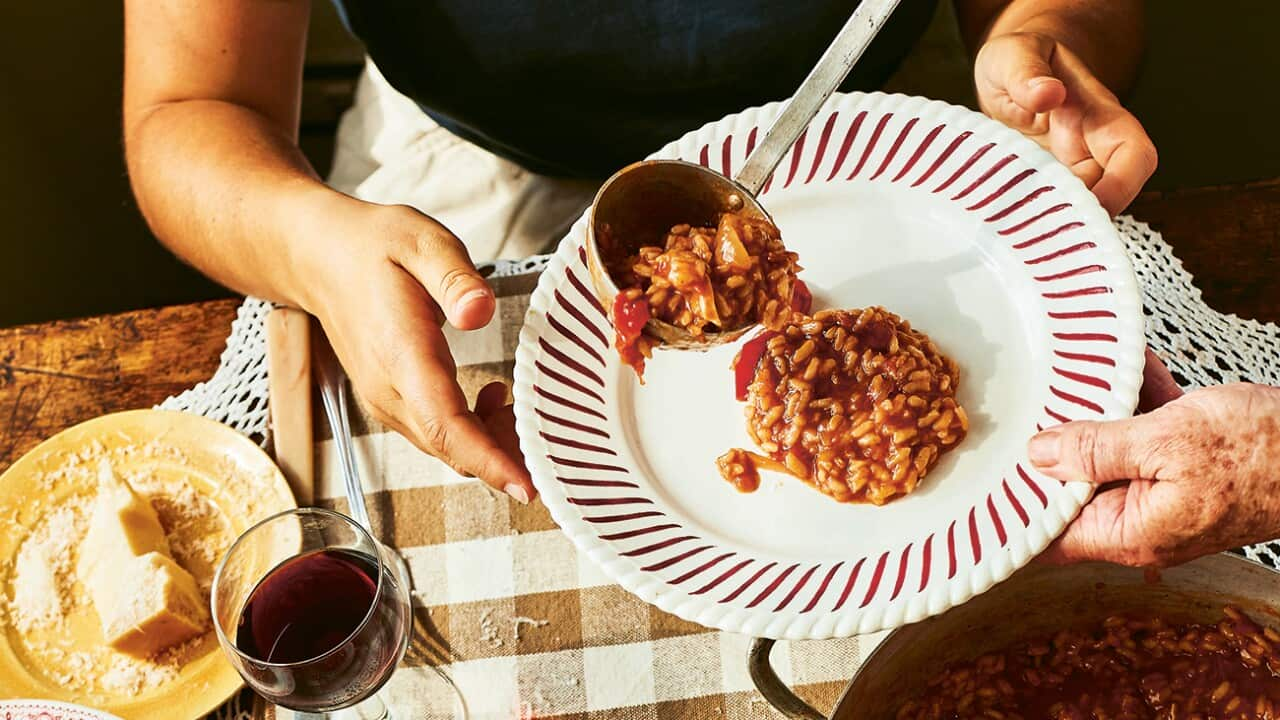Stream free On Demand

Stanley Tucci: Searching for Italy
series • cooking
M
series • cooking
M
Stanley Tucci has the most important qualification for hosting an Italian food and travel show. It's not his Italian heritage, and his ability to chat in Italian with the cooks, chefs, bartenders, growers and others he meets. It's not his witty, entertaining way with words, nor that 'something' that makes him so compelling on screen. Those are all , of course, but there's something else that makes him exceedingly well qualified for taking us on a food-lovers jaunt.
It's his willingness to try almost anything.
In the opening episode of season two, Tucci is in Venice and immediately, his familiar voice narrating the opening shots of the water city sets the tone for another clever and highly entertaining series. "It's the fifth century. You're an urban planner pitching an idea, 'A city in the sea...' you say, '...built on stilts, canals instead of streets. You can only get there by boat.' And, incredibly, they built it.'
Soon Tucci is off to eat what the locals eat, in the places they go to eat. First up, All'Arco, a wine bar in the Rialto area (the city's fish market district). Matteo Pinto, who runs the barcaro, asks him "Is there anything you don't like"? "No, mangio tutto! (I eat everything!)", Tucci replies. And if you've watched the first series, you'll know that's true. He doesn't pretend he loves everything (unsalted Tuscan bread gets a blunt 'tastes like cardboard' comment in the first season), but he's keen to try whatever is on offer – even a raw onion, during his travels in Calabria! – and when he does love it, the enjoyment is clear.
This second season sees the award-winning actor travelling through Venice, Umbria, Piedmont, Puglia, Calabria (an area with family ties for Tucci, and his parents, who join him in the region), Sardinia, Liguria and a destination far beyond the Italian Peninsula: London, his current home, where he explores the rich Italian culinary scene.

Stanley Tucci enjoys a meal in Puglia. Credit: CNN
Here's a taste (and some recipes to fuel your viewing) of what's coming up in season two.
Episode 1 Venice
As well as cicchetti ("This is fast food, lagoon style. The word cicchetti means "a nothing". Ironic because it's really something," says Tucci of the creative little bites Venice is known for) at All'Arco, he also heads off with a local gondolier to try more of the small snacks at a popular boatman's hangout. Traditional snacks like sardine sour and baccalà mantecato feed his appetite for trying more modern cicchetti inventions, too. If you'd like to join the Venetian snack mood, we suggest Emiko Davies' recipes for (her favourite of all Venice's chichetti, she says) or . Or try what Tucci calls the king of cicchetti with or , a slightly different take on baccalà mantecato.

Credit: Chris Chen
Episode 2 Umbria
While this small, predominantly rural region lives in the shadow of its more glamourous neighbour, Tuscany, Umbria has an ancient history that predates even the Romans. Here Tucci finds out more about the local tradition of wild boar hunting and eats pappardelle with wild boar ragu; visits an estate known for truffles (Umbria is the largest producer of black truffles in Italy) and enjoys a dish of spaghetti with mushrooms, beetroot and grated truffle; and visits Perugia and Orvieto. Porchetta, salami, the local no-salt bread (perfect with salami!) and pigeon are all on the menu during his travels. If you're craving porchetta after watching this one, try , or recipe.
Episode 3 Piedmont & Valle D'Aosta
Things start on a sweet note in Piedmont, when Tucci drinks bicerin, a hot drink made of layered espresso, hot chocolate and thick cream, during a visit to Turin. The episode also sees him visit Piola da Celso, a local gem that champions Piedmontese cuisine in its most traditional form as promoted by the slow food movement. Owner and Chef Elisabetta prepares the dangerously garlicky bagna càuda, a comforting cucina povera staple, in addition to veal and tuna sauce, a Piedmontese delicacy not often found in other regions. Rice often takes over from pasta in Piedmont, and Tucci visits a Michelin-starred restaurant in Vercelli that's turning rice into edible works of art. White truffles and barolo, the red wine the area is famous for, also feature on his travels here, which also include a visit to the neighbouring region of Valle D'Aosta. For viewing this episode, get garlicky with the recipe Antonio Carluccio shared with Poh Ling Yeow.
Episode 4 London

Stanley Tucci at La Mia Mamma in London. Credit: CNN / Will Bruce

Ragu alla napoletana di Gennaro Credit: Tammi Kwok
Episode 5 Puglia
While Puglia is famous for its fragrant olive oil, beautiful vegetables, and cheeses, it is also one of Italy’s poorest regions. From Bari’s raw seafood to Cisternino’s Fornelli and Foggia region‘s burnt grain to cheesemaker Vito’s Apulian blue cheese, Tucci tastes dishes that exemplify this region’s sense of community and innovation. Humble dishes traditionally associated with poverty, known as ‘cucina povera’, are being transformed into world-class cuisine. He also makes a visit to the city of Matera, once part of Puglia but now officially part of the neighbouring region of Basilicata. In Bari, he joins in the ancient Barese tradition of raw fish; and visits 'orecchiette road' in Bari Veccia, where women sit outside their houses, making orecchiette to sell. In Foggia, the breadbasket of Italy, Stanley meets Pietro Zito, a chef who is on a mission to revive the simple flavours of Puglia’s past. He takes Tucci to meet Nicola L’Agrasta, who has developed a modern technique for recreating “Grano Arso,” a type of burnt grain that used to be produced by the poorest farmers. After harvesting, the fields used to be burned to remove the remaining wheat stalks, but this process always left some kernels on the ground, which were then collected and used to make dark flour. Now, burnt wheat is created by toasting the grain, which produces flour that Zito uses to make dark pasta in his restaurant, Antichi Sapori. Olive oil and outstanding local cheese also get a turn in Tucci's food-fascinated spotlight.

More delicious eats, this time in Puglia. Credit: CNN
Episode 6: Calabria
All four of Tucci's grandparents emigrated from Calabria, so a visit here would be special anyway, but this time he's joined for some of his wanderings by his parents, Joan and Stan. After a visit to Marzi, the birthplace of the grandfather after whom he is named, he visits a nearby bakery, Panificio Cuti, where bread is still made using traditional Calabrian methods. For the Tuccis, baker Pina Olivetta makes moresello, a bread stuffed with meat and cime di rapa, a portable meal that was popular with farmers, hunters and even stone masons, like Tucci's grandfather.

In Calabria, Stanley Tucci visits Panificio Cuti, where baker Pina Olivetti makes morsello, bread filled with meat and cime di rapa. Credit: CNN

Stanley Tucci and his parents at a family feast in Calabria. Credit: CNN
Episode 7: Sardinia
The food of Sardinia has a multitude of influences, from the waves of settlers throughout history. Tucci discovers the two very different sides of Sardinia - the coast, and the rugged inland. He starts in the island capital, Cagliari, with a visit to the enormous San Benedetto market, and a taste of grey mullet bottarga, also known as 'Sardinian caviar'. At a Michelin-starred restaurant, he eats a staple Cagliaritano dish, fregola ai frutti di mare, with fregola – a North African-inspired pasta - sea greens and fresh seafood. Travelling inland he meets a beekeeper and experiences his first taste of ‘bitter honey’ made from the autumnal blossom of the local corbezzolo trees. Bitter honey has caused a stir since the Roman times when Cicero was famously unimpressed by the flavour, and even now its unusual, bitter taste continues to divide. However, it's perfect on a meal of spit-roasted lamb. Also part of his Sardinian adventures: a visit to a shepherd high on a mountain and a chance to try the man's pecorino cheeses; a boat ride to an annual fishing event on the island of San Pietro; and a visit to Sardinian food expert Simonetta Bazzu at her culinary school located in her ancestral village of Battista. Bazzu is fiercely proud of her cultural heritage and is on a mission to preserve the cuisine of the past. Tucci tastes freshly baked pane carasau, an ancient unleavened bread made in a wood-fired oven, and is astonished to see how this crispy bread, once softened with warm stock, completely changes its form.

Stanley Tucci with Sardinian food expert Simonetta Bazzu. Credit: CNN
Bazzu treats Tucci to a zuppa Gallurese, made with pane carasau soaked in sheep broth, topped with heaps of cheese and wild mint, and baked in the oven until brown. Embrace the flavours of his adventures with recipes such as , , , or .
Episode 8: Liguria
Liguria is a crescent right on the coast of Italy bordering Tuscany and France. The angularity of its landscape determines what the people of this region eat and their narrow, terraced fields force them to be creative with what they grow and how they harvest it. To explore how Ligurian people grow the herbs that form the basis of their cuisine, Carlo Cracco – one of Italy's most famous, Michelin-starred chefs – takes Tucci to meet Iva Lavagnino, an octogenarian farmer who cultivates crops and forages for wild food. The staple of Ligurian cuisine, however, is pesto. Its key ingredient is fresh basil, but not just any type of basil. Tucci visits a special basil farm with Roberto Panizza, the king of pesto and founder of the Pesto World Championship. They discuss how the best basil must be grown and harvested in a particular way. In this “green ocean” the aroma is intense, increasing Tucci’s appetite for the marvellous trenette al pesto – one of his favourite things in the whole world. Embrace the green with , made with a traditional Ligurian pesto.

A classic regional dish, complete with Ligurian pesto. Source: Supplied
Reaching the end of his travels, Tucci cooks a meal for his crew. "I’ve decided to cook a meal for those who have laboured so hard to help me make this series. As we prepare the meal together, I cannot help but think of the meals I have shared ... with Italians from so many different regions and walks of life.
"I’ve travelled through this peninsula searching for a definition of a country that is at once welcoming and resistant, beautiful and dark, ancient and young.
"Yes, pieces of the country we all know as Italy are to be found in the hills, fields, homes, mountains, castles, ruins and medieval streets, but my search has led me to realise that Italy as a single, pure entity is to be found only at the table."









